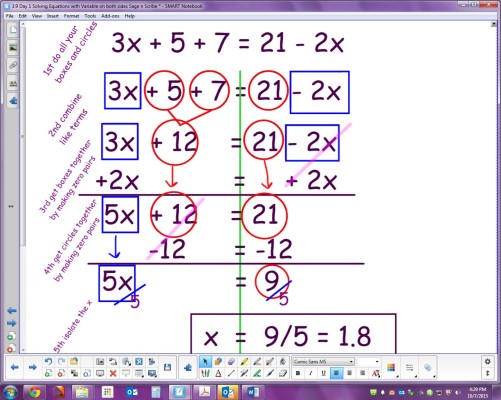Click here to go to the IXL website for all kinds of 8th grade topics and review problems.
Equations
What is an equation?
Examples: 4 + 3 = 7 or 3x + 5 = 10
An equation is a number sentence. We call it an equation because it has an equal sign.
The 5 Steps to Writing an Equation or Inequality
Step 1. Read and underline the question
Step 2. Find your Χ (your variable/unknown) and BOX it
Step 3. Circle the Math Words (product, quotient, each, per, together, sum, difference, squared)
Step 4. Replace the operation words with their symbols ( • , + , – , ÷ , / , = , < , > , ≤ , ≥ ,√ , ≠ , ² , ³ )
Step 5. Write the equations
Don’t forget our cool ‘dance’ we did to remember this!
WRITING EQUATIONS PRACTICE PROBLEMS:
Click here to practice Writing Equations online and get automatic feedback (it grades it)! 🙂
With Equations, Inequalities and Expressions we always want to combine like terms 1st!
Here is an example on how to do that:
Once all like terms have been combined then we can solve.
Solving Equations with Models

To create your own equations using models click here!
MODELING EQUATIONS PRACTICE PROBLEMS:
Click here to practice Modeling Equations online and get automatic feedback (it grades it)! 🙂
Solving Equations Algebraically
Here is another example solving algebraically
Solve √(x/2) = 3
| Start With | √(x/2) = 3 | |
| Square both sides: | x/2 = 32 | |
| 32 = 9: | x/2 = 9 | |
| Multiply both sides by 2: | x = 18 |
And the more “tricks” and techniques you learn the better you will get.
Here is an example of how we solved equations in class:
SOLVING EQUATIONS (with variables on both sides PRACTICE PROBLEMS:
Click here or here to practice Solving Equations online and get automatic feedback (it grades it)! 🙂
Systems of Equations
For information on systems of equations click here.
Simple vs. Compound Interest
Introduction to interest:
http://www.mathsisfun.com/money/interest.html
SIMPLE INTEREST
I = Prt
- I = interest owed [$] (this is ONLY the interest borrowed)
- P = amount borrowed (called “Principal”) [$]
- r = interest rate [%] (you have to divide the percent by 100) For information On Percents click here!
- t = time [years]
Simple interest is money you can earn by investing some money (the principal). The interest (percent) is the rate that makes the money grow!
COMPOUND INTEREST
A = P(1+r)^t
- A = All of it / Actual / total amount owed (this amount includes the interest and the principal) [$]
- P = amount borrowed (called “Principal”) [$]
- r = interest rate [%]
- t = time [years]
Compound interest is very similar to simple interest. The difference is that compound interest grows much faster! The reason it grows faster is because the interest (percent) has an exponent.
********** MAKE SURE TO READ THE QUESTION AND SEE EXACTLY WHAT IT IS ASKING DOES IT JUST WANT THE INTEREST OR THE TOTAL (All of it) ???????? *************************
For information on compound interest click here.
SIMPLE INTEREST PRACTICE PROBLEMS:
Click here or here to practice Simple Interest online and get automatic feedback (it grades it)! 🙂
COMPOUND INTEREST PRACTICE PROBLEMS:
Click here or here to practice Compound Interest online and get automatic feedback (it grades it)! 🙂









